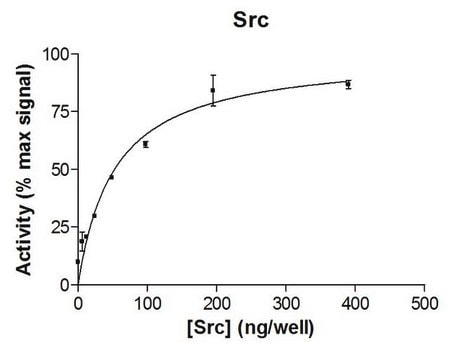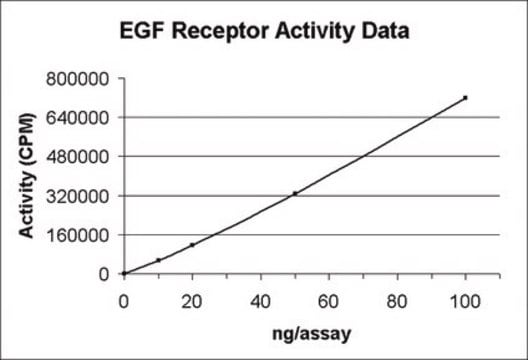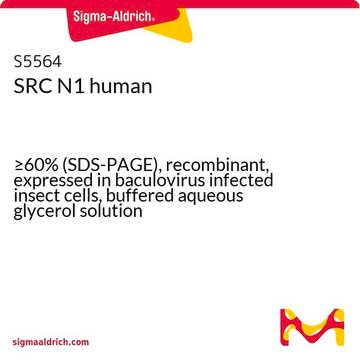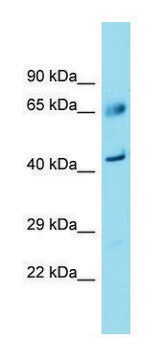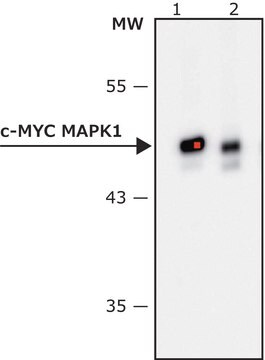14-326-M
Src Protein, active, 10 µg
Active, N-Terminal His6-tagged, recombinant, full-length, human Src. For use in Kinase Assays.
Synonym(e):
SRC1
Anmeldenzur Ansicht organisationsspezifischer und vertraglich vereinbarter Preise
Alle Fotos(2)
About This Item
UNSPSC-Code:
12352202
eCl@ss:
32160405
NACRES:
NA.26
Empfohlene Produkte
Biologische Quelle
human
Qualitätsniveau
Rekombinant
expressed in Sf21 cells
Form
liquid
Mol-Gew.
Mw 61.7 kDa
Hersteller/Markenname
Upstate®
Methode(n)
activity assay: suitable (kinase)
Löslichkeit
soluble
NCBI-Hinterlegungsnummer
UniProt-Hinterlegungsnummer
Angaben zum Gen
human ... SRC(6714)
Allgemeine Beschreibung
Research area: Cell Signaling
N-Terminal His6-tagged, recombinant, full-length, human Src.
Src proteins are non-receptor protein tyrosine kinases, that belong to the Src family of kinases. These proteins have a unique structure consisting of an N-terminal region with a 14-carbon myristoyl group, two Src homology domains (SH2 and SH3), a catalytic tyrosine-protein kinase domain (SH1), and a short C-terminal tail. The SH1 domain is catalytic in function, while the SH2 and SH3 domains are non-catalytic and regulatory in nature.
Product Source: Human c-src, expressed in Sf21 cells.
N-Terminal His6-tagged, recombinant, full-length, human Src.
Src proteins are non-receptor protein tyrosine kinases, that belong to the Src family of kinases. These proteins have a unique structure consisting of an N-terminal region with a 14-carbon myristoyl group, two Src homology domains (SH2 and SH3), a catalytic tyrosine-protein kinase domain (SH1), and a short C-terminal tail. The SH1 domain is catalytic in function, while the SH2 and SH3 domains are non-catalytic and regulatory in nature.
Product Source: Human c-src, expressed in Sf21 cells.
Anwendung
The Src protein may be used to study the interaction between CD133 and Src protein and its effect on FAK phosphorylation and cell migration through in vitro kinase assay.
Biochem./physiol. Wirkung
Src protein tyrosine kinases are involved in signaling pathways that control a plethora of cellular functions ranging from cell cycle, proliferation, differentiation, gene transcription, immune responses, apoptosis, etc. Upon its activation, Src phosphorylates and activates several other kinases Like MAPK (Mitogen-Activated Protein Kinase), p38, and ERK (Extracellular signal-regulated kinase). Activated MAPK (Mitogen-Activated Protein Kinase) regulates inflammation, cell development, differentiation and senescence. P38 is involved with the migration and survival of endothelial cells and extracellular signal-regulated kinase (ERK) promotes the proliferation and inflammation of endothelial cells. They play a key role in the regulation of cytoskeletal organization through the phosphorylation of substrates like Actin filament-associated protein 1 (AFAP1) and cortactin (CTTN). Src also plays a crucial role in maintaining cell adhesion, morphology, motility, and bone resorption by interacting with focal adhesion kinases. Src tyrosine kinase activity is upregulated in a variety of cancers including colon, lung, and pancreatic cancer, etc.
Verpackung
2 vials at 5μg each
Also available in 250μg size (2x125μg)--call for pricing and availability and reference catalog number 14-326M when ordering the 250μg size.
Also available in 250μg size (2x125μg)--call for pricing and availability and reference catalog number 14-326M when ordering the 250μg size.
Qualität
Routinely evaluated by phosphorylation of Src Substrate Peptide
Sonstige Hinweise
For Specific Activity data, refer to the Certificate of Analysis for individual lots of this enzyme.
Rechtliche Hinweise
UPSTATE is a registered trademark of Merck KGaA, Darmstadt, Germany
Signalwort
Warning
H-Sätze
Gefahreneinstufungen
Skin Sens. 1
Lagerklassenschlüssel
12 - Non Combustible Liquids
WGK
WGK 2
Flammpunkt (°F)
Not applicable
Flammpunkt (°C)
Not applicable
Analysenzertifikate (COA)
Suchen Sie nach Analysenzertifikate (COA), indem Sie die Lot-/Chargennummer des Produkts eingeben. Lot- und Chargennummern sind auf dem Produktetikett hinter den Wörtern ‘Lot’ oder ‘Batch’ (Lot oder Charge) zu finden.
Besitzen Sie dieses Produkt bereits?
In der Dokumentenbibliothek finden Sie die Dokumentation zu den Produkten, die Sie kürzlich erworben haben.
Protein tyrosine kinases, with emphasis on the Src family.
Courtneidge, S A
Seminars in Cancer Biology, 5, 239-246 (1994)
Jianhui Ma et al.
Cancer cell, 35(3), 504-518 (2019-03-05)
Ionizing radiation (IR) and chemotherapy are standard-of-care treatments for glioblastoma (GBM) patients and both result in DNA damage, however, the clinical efficacy is limited due to therapeutic resistance. We identified a mechanism of such resistance mediated by phosphorylation of PTEN
Unser Team von Wissenschaftlern verfügt über Erfahrung in allen Forschungsbereichen einschließlich Life Science, Materialwissenschaften, chemischer Synthese, Chromatographie, Analytik und vielen mehr..
Setzen Sie sich mit dem technischen Dienst in Verbindung.